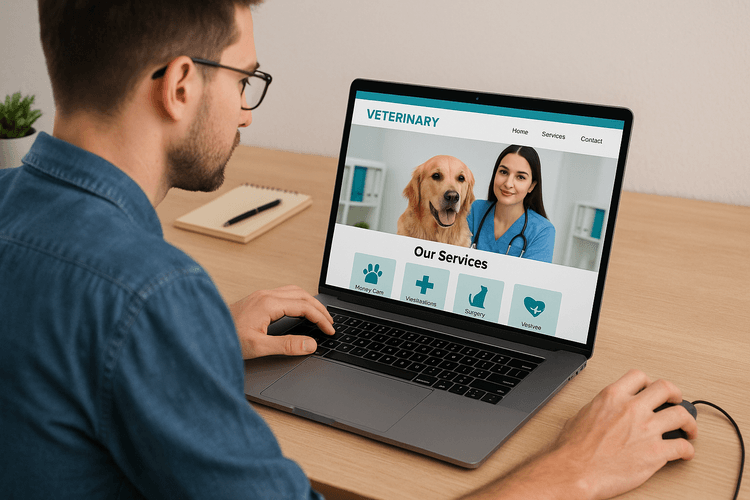
Creating a website for a veterinarian can be an excellent digital marketing strategy to promote your business and more easily reach your clients. Thanks to Framework360, the complete cloud digital marketing platform, creating a professional and functional website is easy and quick.
After registering for free at the following link https://www.framework360.com/try-free/, you will have access to all the functionalities of the platform, including a theme generator that uses artificial intelligence to create websites with modern and appealing designs.
In the "Website" section, you can customize the pages of your website thanks to the convenient visual block builder. Furthermore, with marketing features such as campaigns with automations and newsletters, you can build customer loyalty and increase the number of bookings at your veterinary clinic.
In this article, we will see step by step how to create a website for a veterinary practice using Framework360.
Defining the website's goals

Before starting the creation of your veterinary clinic's website, it is necessary to define the goals you want to achieve through the site. The objectives can vary from one practice to another, but some examples might include:
- Promoting the services offered by the veterinary clinic;
- Increasing the number of regular clients;
- Providing detailed information about the services offered in order to offer more transparency to clients;
- Creating an online community of pet enthusiasts.
Once the main objectives are defined, it will be possible to create a website that aligns with these goals. For example, if the main goal is to promote the services offered by the clinic, it will be important to dedicate a specific page to each service offered. In this way, visitors to the site will easily find the information they are looking for and will be more encouraged to book an appointment at the clinic.
Instead, if you want to create an online community, you might add a blog or an "Animal Stories" section where customers can share their experiences with their pets. This can increase the engagement of visitors to the site and, in turn, lead to greater involvement with the clinic.
Choosing a domain name and hosting

The first thing to do when you want to create a website for a veterinary clinic is to choose the domain name and hosting. The domain name is the address that users type into the address bar of their browser to access your website, while hosting represents the web space where your site will be hosted.
Choosing the domain name
The domain name should be easy to remember and type, preferably short and descriptive, so that users can immediately understand what your website is about. If possible, try to avoid overly complicated or difficult-to-remember names.
Furthermore, make sure that the domain name is available. You may find that a certain domain name you had in mind has already been registered by someone else. In this case, you will need to look for an alternative one.
Once you have found an available domain name, you will need to register its ownership. There are many online services that offer domain name registration, so choose the one that best fits your needs.
Choosing hosting
The hosting is the web space where your site will be uploaded. There are many different hosting providers to choose from, but it's important to find one that best suits your needs.
First of all, assess your needs in terms of web space. If your veterinary clinic's website mainly contains information and images, a hosting plan with limited storage capacity might suffice. However, if you plan to use your site to sell products or services online, you might need more storage space.
Moreover, consider the speed and reliability of the hosting. A slow or unreliable hosting can cause problems for your site's visitors and damage your online reputation.
Finally, also take into account the price of the hosting. There are many hosting providers at different prices, so look for one that fits your budget best.
- Example of a low-cost hosting provider: Aruba
- Example of a premium hosting provider: Kinsta
Choosing the right domain name and hosting for your veterinary clinic's website is crucial to ensure a good user experience for users and to grow your online presence.
Creating the website structure

Before starting to think about design and content, it is important to create a solid structure for your website. This step will help you organize information in a clear and consistent manner for visitors.
Sitemap
The first thing to do is create a site map or "sitemap". This is a visual representation of the structure of your website. You can use an online tool like Draw.io or MindMeister to easily create your sitemap.
In general, a sitemap should include:
- Homepage: this is the main page of your website, which contains basic information about your business and a navigation menu.
- Service pages: if you are a veterinarian, you might have pages dedicated to your services, such as "Veterinary Visits", "Vaccinations", and "Dental Care".
- Informational pages: here you can include useful information about your services or areas of expertise. For example, you could have a page titled "How to Take Care of Your Dog" or "Senior Cat Nutrition".
- Contact Page: this last one should contain all the contact information for your business, including email address, phone number, and physical office address.
Navigation menu
Now that you have created your sitemap, it's time to think about the navigation menu of your website. The menu should reflect the structure of your sitemap and make it easy for visitors to find what they are looking for.
In general, a good navigation menu should include:
- Home: this should be the first item in your menu, taking visitors to the homepage of your site.
- Services: here you can include all the pages dedicated to the services offered by your business.
- About: in this section, you can include all the informative pages of your website.
- Contact: this last section should contain all the contact details for your business.
Remember to keep your menu simple and intuitive to use. Do not create too many entries or different categories, otherwise, you risk confusing your visitors.
Now that you have created a solid structure for your website and have developed a clear and intuitive navigation menu, you're ready to move on to the next phase: designing the site!
Add relevant content for veterinary clients

After creating your veterinary practice's website on Framework360, it is important to add useful and interesting content for your clients. This will help you retain them and bring them back to your website.
Create a blog
A good idea might be to create a blog within your website. By doing so, you can write informative articles about the various types of pets, their needs, and the care they should receive. For example, you could write an article on the importance of cleaning your dog's teeth or about disease prevention in cats.
This way, your clients can learn something new and find helpful advice for taking care of their pets.
Showcase your skills
Including an "About Us" section on your website can help showcase your skills as a veterinarian. You can list your qualifications, your work experience, and also talk about the Your passions regarding the work you do.
In this way, your clients will have more trust in your work and will feel confident in contacting you, knowing they are entrusting themselves to a competent professional.
Offer online services
On Framework360, it will be possible to create a "Book Online" section where your clients can schedule visits and appointments directly from your website. This saves time for both you and the client and makes the booking process more convenient.
Moreover, you can also offer online consulting services through video calls or chat. This can be particularly helpful for clients who cannot reach your office or have difficulty moving around.
Create a photo gallery
Create a photo gallery on your website showing pictures of your happy and cared-for patients. People love to see pets smiling and showing their gratitude towards those who care for them.
- You could include photos of animals after surgery or after being treated for serious illnesses.
- You can also add pictures of adorable puppies being checked by you during pediatric visits.
Including a photo gallery on your website can help enhance the image of your veterinary practice and show how much you love and care for pets.
Search engine optimization (SEO)

Search engine optimization, also known as SEO, is a crucial aspect of creating a website. SEO helps to improve the visibility of your site in search engine results and to attract organic traffic.
Keywords
The first thing to do to optimize your website is to choose the right keywords. Keywords are what users type into search engines to find information on a particular topic. For example, if we are creating a website for a veterinarian, the keywords might be "veterinarian", pet care", "veterinary visits" and so on.
It is important to use keywords strategically within the website, for example in page titles, page content itself, and in meta descriptions. However, it is necessary to avoid using them excessively or artificially, as this could lead to being penalized by search engines.
Quality Content
Content represents one of the most important factors in SEO. A site with original, relevant, and interesting content will have a better chance of ranking well on search engine results compared to a site with generic or duplicated content.
Moreover, the content must be well-structured, with titles and subtitles that help users navigate easily within the site. Using our veterinarian website example, we could create a section called "Services" with subcategories such as "Veterinary Visits", "Vaccinations", Animal Care" and so on.
Link Building
Link building is another important aspect of SEO. Link building involves trying to acquire links to your own website from other authoritative and relevant websites in your industry.
For example, if we have created a website for a veterinarian, we might try to get links from websites of professional associations or from blogs about the pet world.
Mobile Friendly
Nowadays, it is essential for a site to be mobile friendly, meaning that it must be accessible also from mobile devices such as smartphones and tablets. Indeed, more and more people are using these devices to browse the web. Search engines also evaluate a site's usability on mobile devices, so it is important to have a responsive website that adapts to different device sizes.
- Choosing the right keywords
- Creating original and relevant content
- Try to obtain links from authoritative websites
- Have a mobile-friendly website
SEO is crucial for improving the ranking of your site on search engines. Strategically using keywords, creating original and relevant content, trying to obtain links from authoritative websites, and having a mobile-friendly website are just some of the important factors in SEO.
Launch the website and promote it

Now that your veterinary website has been created, you need to promote it to make your services known. Below you will find some tips on how to launch and promote the site.
1. Optimize your site for search engines (SEO)
Make sure your site is optimized for search engines so that people can easily find your business online. This means including relevant keywords in page titles, meta descriptions, site content, and images. Also, ensure that your site is mobile-friendly and has fast loading times.
2. Use social media
Social media is a great tool for promoting your veterinary business online. Create business pages on popular social networks like Facebook, Instagram, Twitter, and LinkedIn. Regularly post interesting and informative content about your veterinary practice and engage with your followers by responding to their questions and comments.
3. Launch an online advertising campaign
An online advertising campaign can help increase the visibility of your website. You can use online advertising tools such as Google Ads or Facebook Ads to create targeted ads for a specific audience. This will allow you to effectively reach potential clients and boost traffic to your website.
4. Collaborate with other industry professionals
Collaborating with other professionals in the veterinary industry can help you reach new audiences. For example, you might partner with a local pet store or another veterinary practice to organize joint events and promote each other's businesses on your respective websites and social media.
5. Ask for feedback
Requesting feedback from your customers can help you improve your website and your business overall. Include a feedback section on your website and ask your customers to leave online reviews on review sites like Google My Business or Yelp. By doing this, you will gain valuable insights into what your customers appreciate about your business and what could be improved.
- Optimize the site for search engines (SEO)
- Use social media
- Launch an online advertising campaign
- Collaborate with other industry professionals
- Ask for feedback
In summary, to best promote your veterinary website, you should use a combination of strategies. Optimize your website for search engines, use social media to connect with your audience, launch a targeted online advertising campaign, collaborate with other industry professionals, and ask for customer feedback. By implementing these techniques, you can reach new clients and grow your business. The text you provided is an HTML snippet and does not contain any translatable content. It consists of closing tags for a paragraph and a div element. In English, it remains unchanged:
You can do it too, you just need a lot of commitment and an excellent marketing and sales platform.
Free trial for 30 days. No credit card required.







